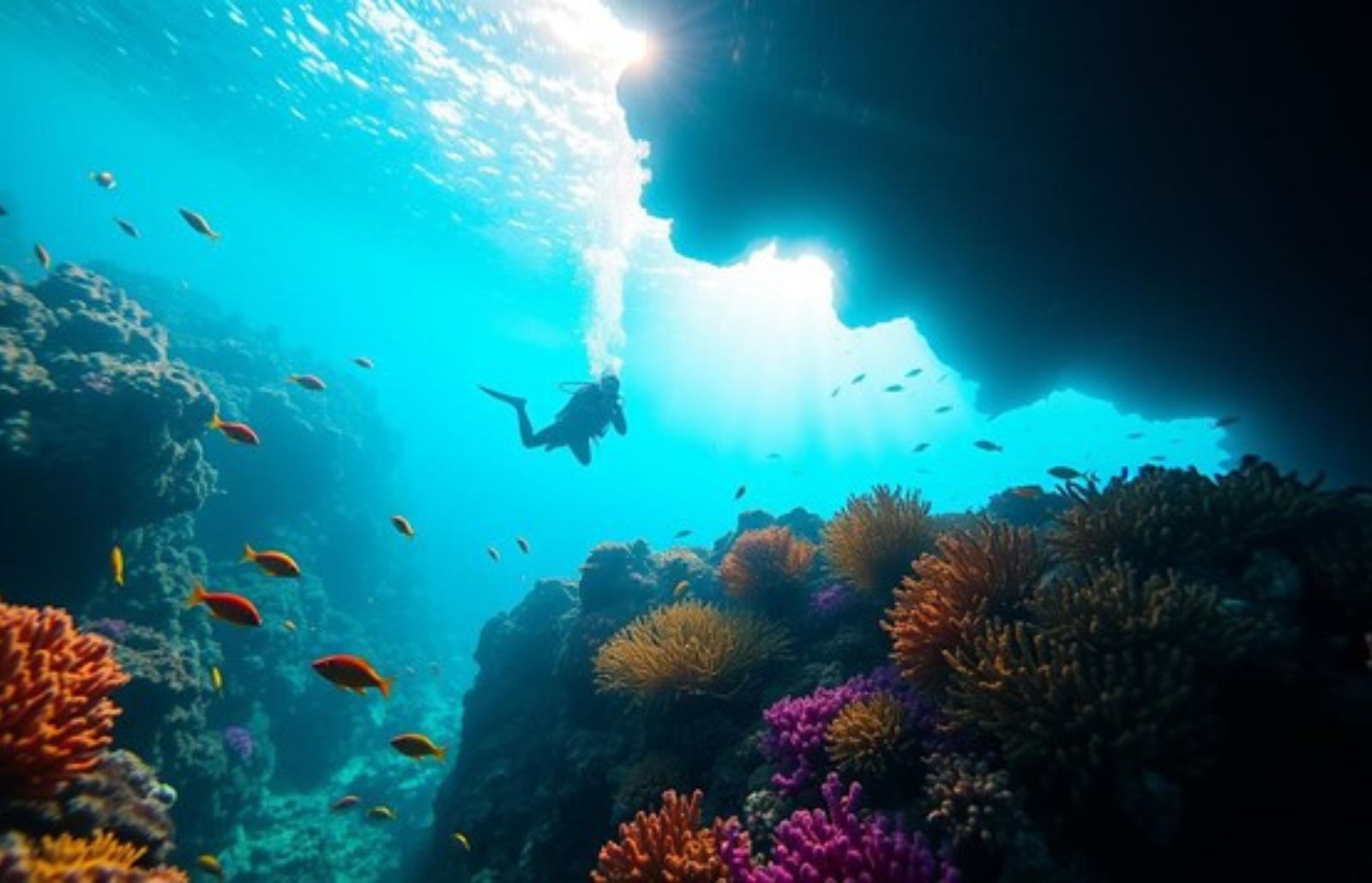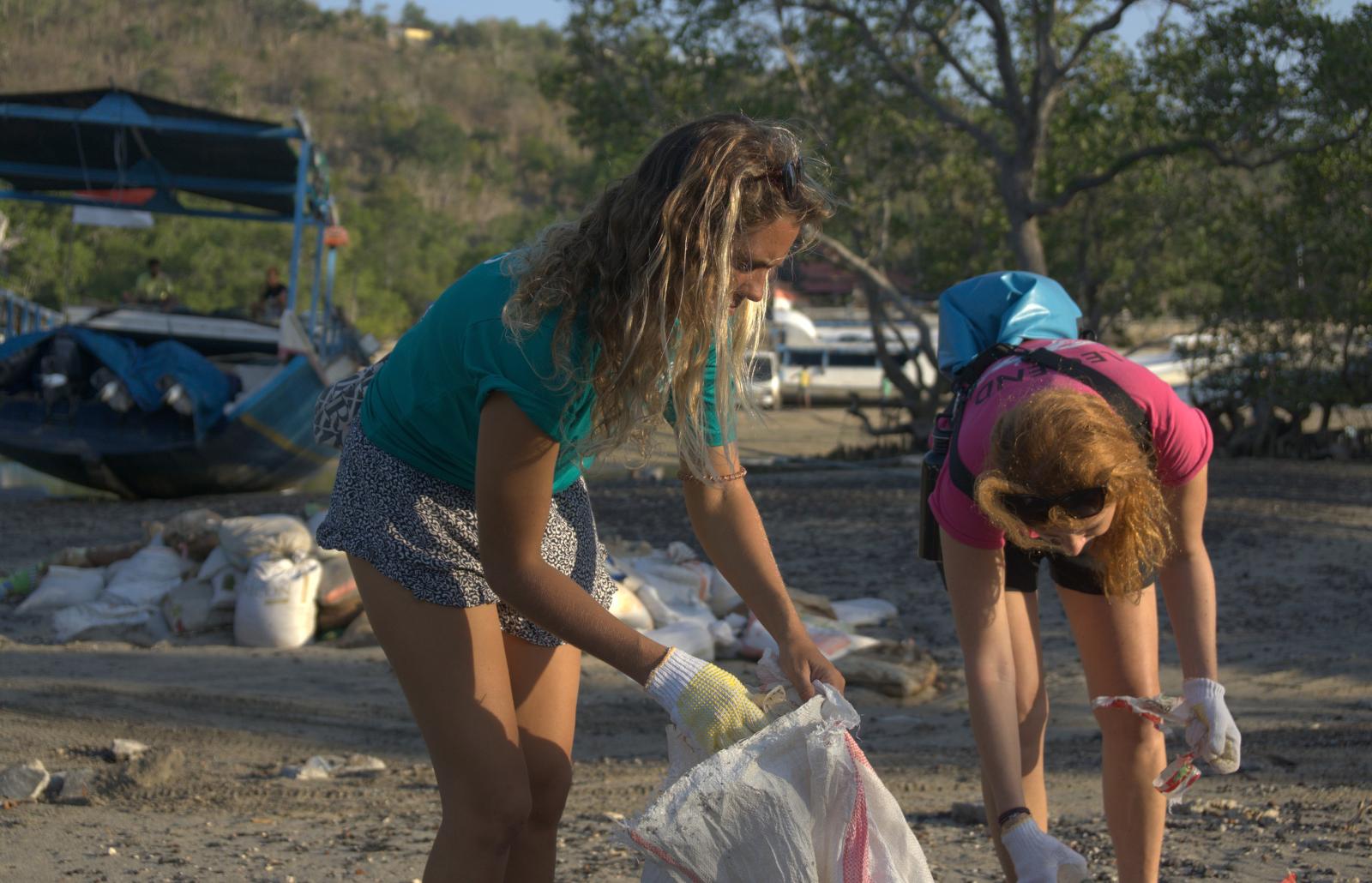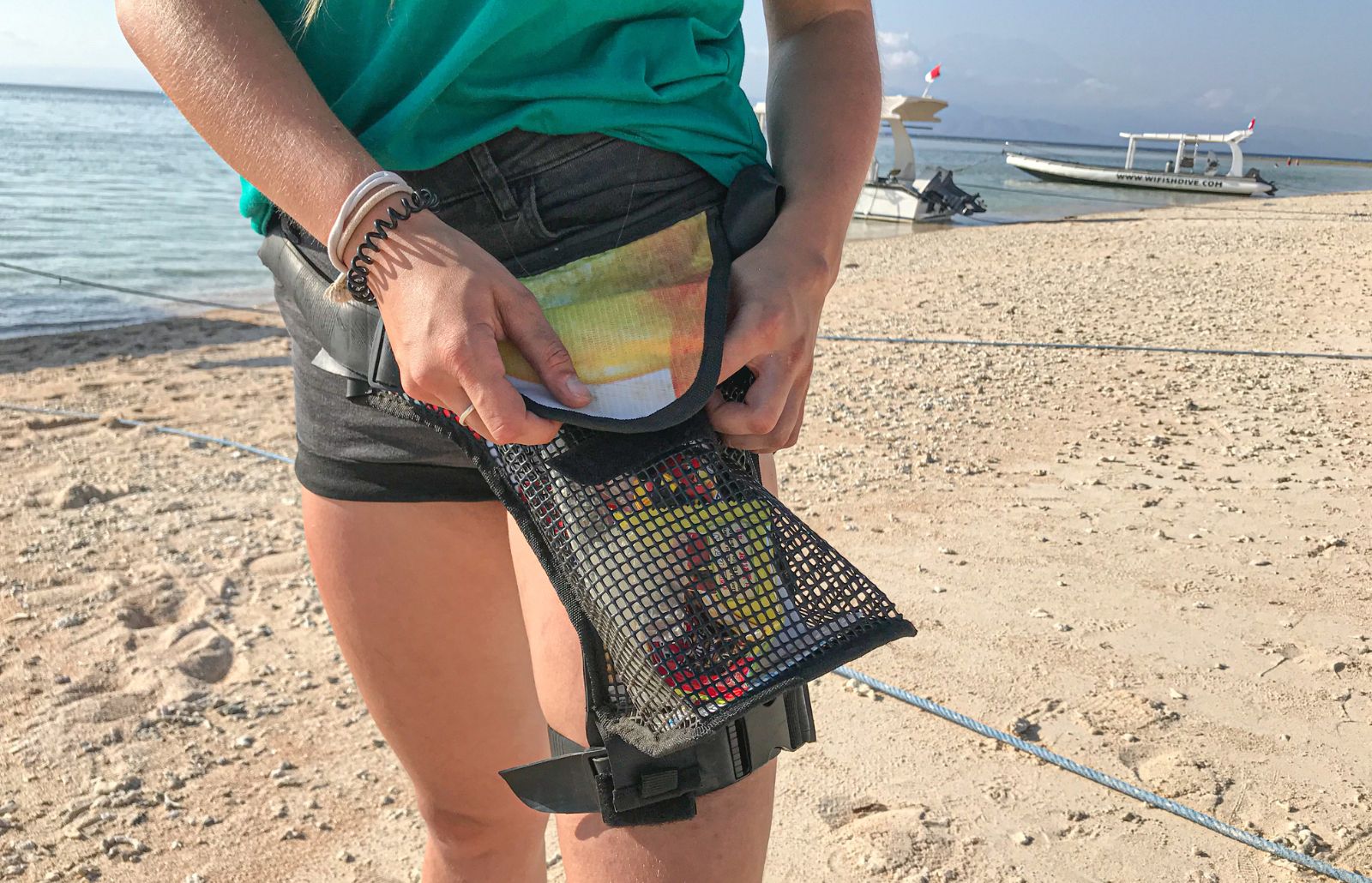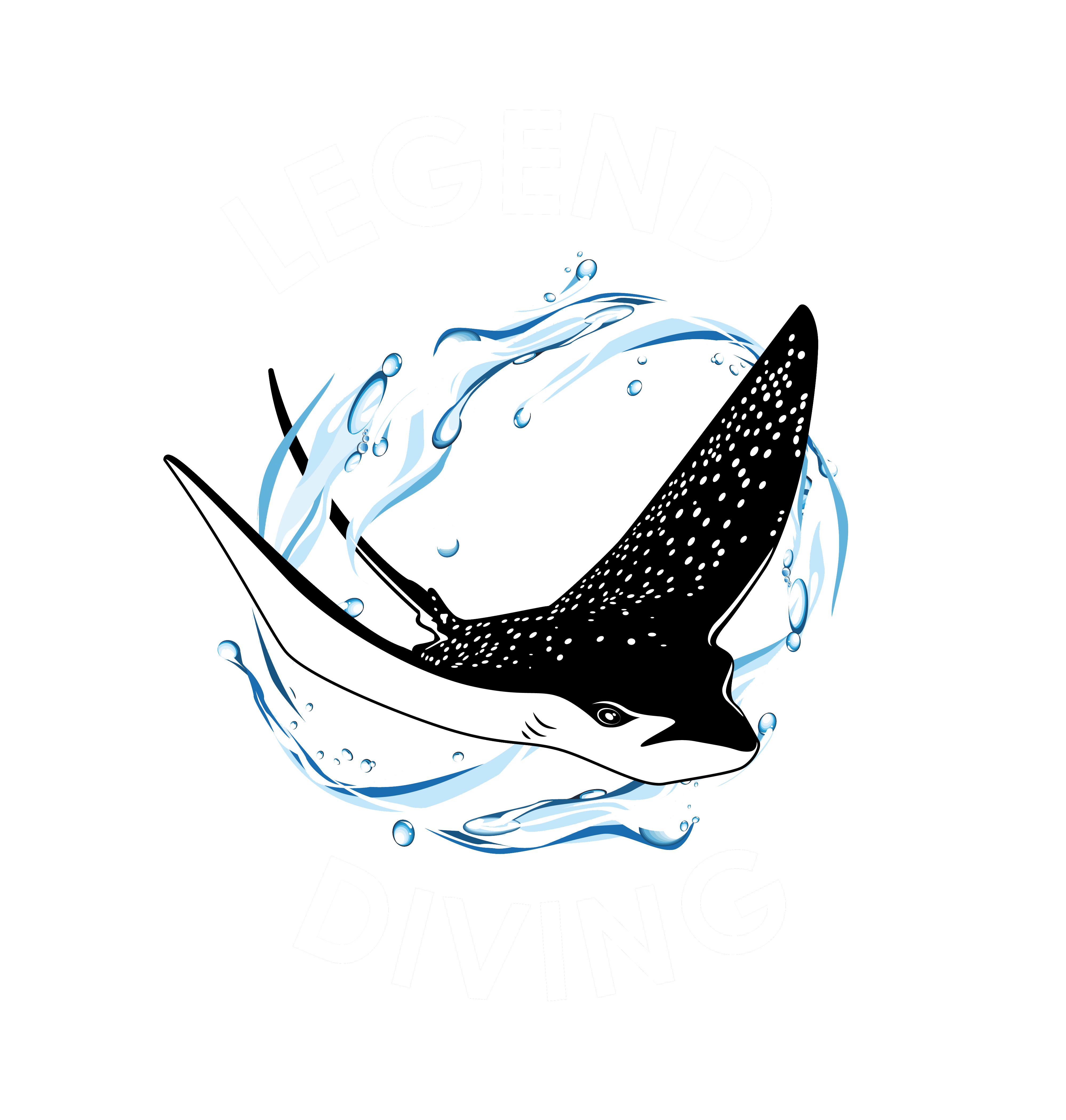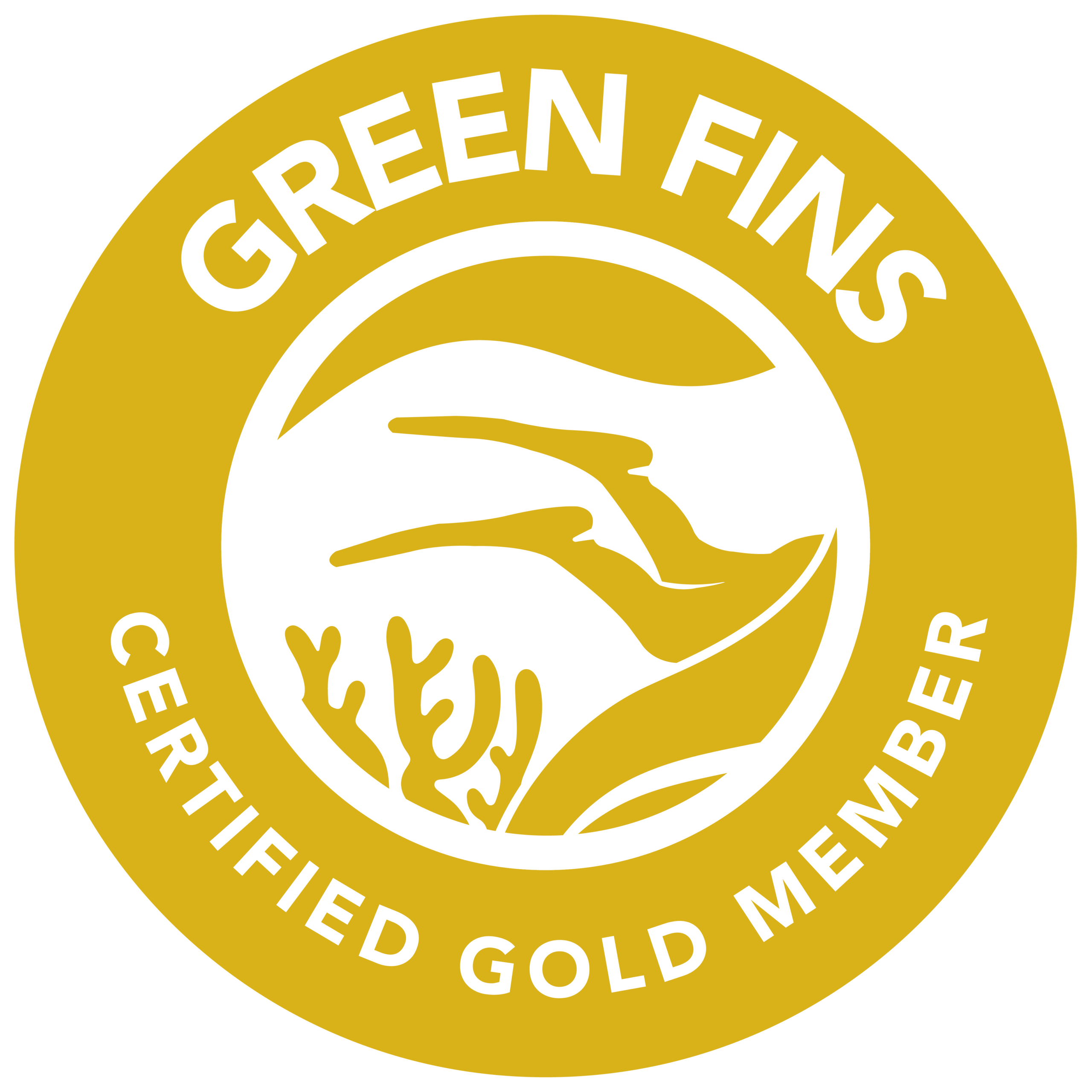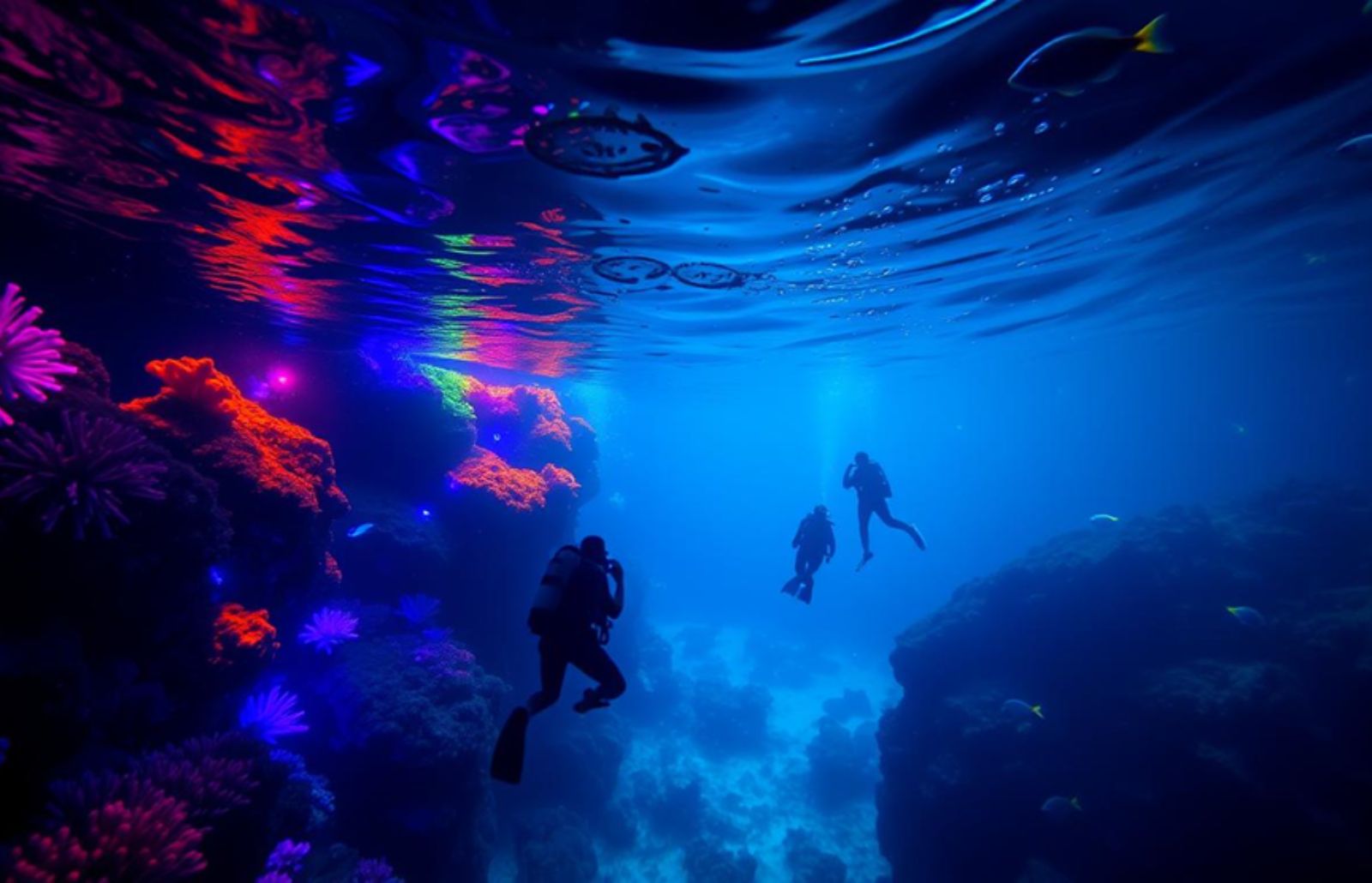
What is Fluorescence Night Diving? A Guide to Fluo Night Diving in Nusa Lembongan
Did you know Indonesia has over 17.500 islands? Each one offers a unique diving experience. Fluorescence night diving, or fluo diving, is a special adventure in Nusa Lembongan’s diverse waters.
This fluo night diving guide shows you how to dive with special UV lights. These lights make marine life glow in the dark. You’ll see corals, fish, and more lighting up the sea in bright colors!
Fluorescence night diving in Nusa Lembongan is more than just a sight. It helps scientists study marine life and coral health. By diving, you get to see the beauty of the sea and help protect it.
What to Remember
- Fluorescence night diving reveals the vibrant, glowing beauty of marine life.
- Nusa Lembongan offers ideal conditions for fluo diving thanks to its rich biodiversity.
- This diving technique involves using special UV lights to excite marine organisms’ fluorescence.
- Fluo diving bridges thrill and education, contributing to coral health and marine biology studies.
- Nusa Lembongan is accessible and popular for year-round sightings of manta rays.
What is Fluorescence Night Diving?
Fluorescence night diving, also called “fluo diving” or “glow diving,” is a unique dive experience. It combines the excitement of night diving with the magic of marine fluorescence. By understanding the science behind fluorescence, divers can see how these amazing visuals are made.
How Does Fluorescence Night Diving Work?
Fluorescence night diving uses special blue or ultraviolet lights and a yellow filter. This lets divers see the natural glow of underwater creatures. When these creatures are exposed to the light, they glow in colors like pink, green, and blue.
What You’ll See
Under the blue light, divers see a world full of coral fluorescence and fluorescing corals. They see glowing fish, corals, and other creatures. The lack of light pollution makes these displays even more vivid, adding to the underwater world’s beauty.
More than 200 species of fish and many other sea creatures glow this way. With so much of the ocean unexplored, there’s always a chance to find something new.
Why Nusa Lembongan is Perfect for Fluo Diving
Nusa Lembongan is the perfect diving destination for fluorescence night diving. Its pristine waters, minimal light pollution, and rich biodiversity make it special. Whether you’re new or experienced, diving here offers a colorful underwater world. The island’s clear waters let us see the vibrant fluorescence, unlike anything seen in the day.
What makes diving in Nusa Lembongan unique are its protected marine areas. These areas show off the diverse fluorescent marine life, making each dive exciting. Imagine seeing corals in over 50 colors or up to 100 different species, each with unique fluorescence patterns during one dive!
How to Prepare for a Fluo Night Dive
Getting ready for a fluo night dive in Nusa Lembongan needs careful planning. Let’s look at the key steps to make sure you’re set for this amazing underwater adventure.
Choose a Reputable Operator
First, pick a reputable diving operator in Nusa Lembongan. Look for those with lots of night dive experience and a focus on diving safety. This means your dive will be led by experts who care about your safety and know the local waters well. Always check reviews and certifications before choosing.
Night Diving Experience Required
Having some night diving experience is key. Night dives are different because it’s harder to see and you need to control your buoyancy well. Getting to know the dive sites during the day helps a lot. If you’re new to night diving, a specialty course can help build your confidence and skills.
Full Wetsuit
A full wetsuit is a must for comfort and diving safety. The ocean can be chilly at night, and a full wetsuit keeps you warm. It also protects you from any marine life you might meet. Make sure your wetsuit fits right to keep the cold out.
Gear Up
Having the right night diving gear is vital for a great fluo dive. You’ll need:
- Blue light torch: This is key for seeing the glowing marine life.
- Yellow filter for your mask: It makes the glow of the marine life even more vivid.
- Backup light: You’ll need this in case your main light goes out.
Also, check that all your gear works well. Make sure your flashlights are fully charged. Go over your dive plan with your buddy before you dive to make sure everything goes smoothly. With the right gear and knowledge, a fluo night dive in Nusa Lembongan is both safe and thrilling.
How Many Lumens Do I Need for Night Diving?
When planning night dives, knowing the lumen ratings is key. A primary dive light should have at least 1200 lumens. For the best view of fluorescent marine life in Nusa Lembongan, aim for 1800 to 3000 lumens. This light intensity is strong enough to show off colors without harming the sea creatures.
Backup dive lights are also vital, mainly for safety. They should have 500 to 1000 lumens. Primary lights shine brightly and focused, but backup lights are there if the main one fails. A good backup light can be a lifesaver in underwater challenges.
Choosing the right lumens for night diving also includes different types of lights. Mask lights, for example, have 250 to 500 lumens. They give enough light for precise tasks without too much glare.
Tips for Fluo Night Diving in Nusa Lembongan
When you go on a fluo night dive in Nusa Lembongan, remember a few key tips:
- Always dive with a buddy and keep in touch. Listen to your guide closely to stay safe and see more.
- Practicing good buoyancy control is also important. It lets you float near the glowing sea creatures without disturbing them.
- Try to use less white light during your dive. White light can scare away the sea creatures and hide the glow. Use blue light with yellow filters instead. This will make the glowing sea life even more beautiful.
- Being aware of your surroundings is key. This helps avoid harming the sea creatures. Stressed corals glow less, so careful diving is important.
- Know the best depth for seeing glowing sea life. In Nusa Lembongan, the best spots are 5–10 meters deep. Here, you’ll see a world of glowing corals, anemones, and fish.
- For a better fluo night dive, make sure you have the right gear. You’ll need blue light torches and yellow mask filters. If you want to take pictures, bring an underwater camera with the right filters.
If you’re new to fluoro diving, get some night diving experience first. Fluorescence diving is fun, but you need to know how to navigate in the dark. Follow these tips to have a magical underwater adventure.
Photography Tips for Fluo Diving
Fluorescence photography lets you see marine life in a new light. It’s a magical experience that requires some special techniques. By using UV light and a yellow filter, adjusting your camera, and trying different methods, you can take amazing photos during fluo night dives.
Use a UV Light + Yellow Filter
A UV light and a yellow filter are key for fluorescence photography. The UV light makes the underwater world glow, and the yellow filter makes the colors pop. Brands like GoBe make great UV lights, and Soyak offers yellow filters that fit easily on your camera.
Manual Camera Settings
For the best fluorescence photos, use manual camera settings. A shutter speed of 1/80 sec, aperture at f/14, and ISO at 1600 work well. These settings help you capture the vibrant colors and details of fluorescent subjects in low light.
Macro Lenses
Macro lenses are essential for capturing the tiny details of fluorescent creatures. They let you take stunning close-ups of small subjects like fish and morays. The Olympus Tough TG-6, with the Ikelite kit, is a great choice for beginners in underwater macro photography.
Experiment with Angles
Trying different angles is key to amazing underwater photos. It can give you unique and dramatic shots that show off the fluorescent beauty of your subjects. Using tools like the Sea & Sea YS-D2J strobe can also help create bright and engaging images. Divers like Alex Mustard recommend using three strobes for even better lighting.
Best Season for Diving in Nusa Lembongan
Timing is key for fluorescence night diving. The best diving season in Nusa Lembongan is from April to October. This aligns with Bali’s dry season. Divers get calm waters, less rain, and clear visibility.
July is a standout month. The water is warm, and marine life is abundant. You can see manta rays and mola-mola up close. Plus, the seas are smooth before the monsoon winds start.
Here’s a detailed look at Nusa Lembongan dive times and conditions for each month within the best diving season:
| Month | Water Temperature (°C) | Visibility | Marine Life Highlights |
|---|---|---|---|
| April | 27-29°C | Excellent | Nudibranchs, reef fish |
| May | 27-29°C | Excellent | Octopuses, colorful reef fish |
| June | 27-30°C | Excellent | Mola-mola sightings begin |
| July | 27-30°C | Outstanding | Manta rays, Mola-mola peak |
| August | 28-30°C | Very Good | Reef sharks, manta rays |
| September | 27-29°C | Very Good | Mola-mola, colorful reef fish |
| October | 27-29°C | Excellent | Octopuses, famous dive sites |
During the dry season, divers can explore many sites each day. They do 2-3 dives, lasting 60-70 minutes each. This gives them a chance to see the glowing marine life.
After mid-July, the winds pick up, making it harder to dive. Plan your dives early in the season for the best experience.
Best Dive Sites for Fluo Diving in Nusa Lembongan
Among the top dive sites Nusa Lembongan, we highly recommend two exceptional locations for fluorescence night diving:
Blue Corner
Diving in Blue Corner is an electrifying adventure, famed for its strong currents and the presence of large pelagic fish. As we embark on this dive, the vivid glow of marine life under fluorescence lights transforms the seascape into a mystical underwater realm. The thrill of encountering majestic creatures like manta rays and reef sharks in their natural habitat is unparalleled!
Lembongan Bay
Lembongan Bay offers a contrasting yet equally stimulating diving experience. Its more sheltered environment is perfect for beginners looking to dip their toes into the night diving world. For those fascinated by the smaller wonders of the ocean, Lembongan Bay is a macro photographer’s paradise. The calm waters here make it ideal to capture the delicate beauty of fluorescent corals and the myriad of smaller marine species.
Both Blue Corner and Lembongan Bay provide incredible opportunities to witness the magic of the ocean come alive under fluorescence lights!
What are The Risks of Night Diving?
1. Limited Visibility
Even with a high-quality dive light, visibility at night is significantly reduced. The narrow beam of your light can create shadows and make it harder to spot hazards, navigate, or keep track of your dive buddy. This can lead to disorientation or accidental separation from your group.
Tip: Always carry a primary dive light and at least one backup light. Use a tank marker light or strobe to make yourself visible to your buddy and others.
2. Marine Life Hazards
Night diving brings you face-to-face with nocturnal creatures, but some marine animals are more active or aggressive after dark. For example, moray eels, octopuses, and crustaceans may behave differently at night. Additionally, creatures like jellyfish or stingrays can be harder to spot, increasing the risk of accidental contact.
Tip: Avoid touching or disturbing marine life. Move slowly and carefully, and keep your dive light pointed downward to avoid startling animals.
3. Equipment Failures
Night diving relies heavily on artificial light sources. If your primary dive light fails, you could be left in complete darkness, which can be dangerous. Equipment malfunctions, such as regulator issues or air supply problems, can also be harder to address in the dark.
Tip: Test all your gear before diving, including lights, regulators, and tanks. Carry a backup light and ensure your equipment is in excellent condition.
4. Increased Physical and Mental Fatigue
Night diving can be more physically and mentally demanding than daytime diving. The darkness, combined with the need for heightened awareness, can lead to quicker exhaustion. This is especially true for inexperienced divers who may feel more anxious or stressed.
Tip: Stay calm and focused. Practice slow, controlled breathing to conserve energy and reduce stress. Dive within your limits and avoid pushing yourself too hard.
5. Decompression Sickness
Night diving often involves deeper dives or longer bottom times, which can increase the risk of decompression sickness (DCS). The darkness may also make it harder to monitor your depth and time, so it’s essential to stay vigilant.
Tip: Use a dive computer to track your depth and bottom time. Ascend slowly and follow safe diving practices to avoid DCS.
Night dives are exciting and new, but safety is key. With the right preparation, these dives can be both fun and safe.
Dive into The Glow!
Diving into the glow of fluorescence night diving in Nusa Lembongan is a unique experience. It’s perfect for both new and seasoned divers. We use special UV lights and yellow filters to see a new world. Here, the ocean’s night creatures show off their most beautiful secrets.
We use special camera filters to capture these wonders. Dive sites like Blue Corner and Lembongan Bay are perfect for this. They are filled with colors from fire-worms, anemones, and corals. This dive is more than just a sight to see. It’s a chance to learn about marine life and help protect the ocean.
Learn More
What is Fluorescence Night Diving?
Fluorescence night diving is a special underwater activity. Divers use special lights to see the glowing colors of corals and marine life. It makes the reef look like a magical world. For more info, check out our guide on fluo night diving in Nusa Lembongan!
Why is Nusa Lembongan Perfect for Fluorescence Diving?
Nusa Lembongan has vibrant coral reefs and rich marine life. The water is clear, making it perfect for diving. Whether day or night, Nusa Lembongan offers a unique underwater experience.
Can You Provide Some Tips for Fluorescence Night Diving in Nusa Lembongan?
Here are some tips: – Dive slowly to enjoy the glowing corals. – Stay close to your buddy for safety. – Use UV lighting and yellow filters for better fluorescence. – Monitor your depth and air supply.
When is the Best Season for Diving in Nusa Lembongan?
The best season is from April to October. The waters are calm, visibility is high, and marine life is abundant. Plan your trip then for the best diving experience.
How Many Lumens Do I Need for Night Diving?
You need at least 1000 lumens for a primary dive light. A backup light with 500 lumens is also useful. The lumen requirement depends on your diving environment and preference.
How Can I Experience the Ultimate Diving Adventure?
Dive with Legend Diving in Nusa Lembongan for an unforgettable adventure. Explore vibrant marine life and top dive sites. It’s an experience that will leave you with lasting memories and a deeper appreciation for marine conservation.
What is Fluorescence Night Diving? A Guide to Fluo Night Diving in Nusa Lembongan
Did you know Indonesia has over 17.500 islands? Each one offers a unique diving experience. Fluorescence night diving, or fluo diving, is a special adventure in Nusa Lembongan’s diverse waters.
This fluo night diving guide shows you how to dive with special UV lights. These lights make marine life glow in the dark. You’ll see corals, fish, and more lighting up the sea in bright colors!
Fluorescence night diving in Nusa Lembongan is more than just a sight. It helps scientists study marine life and coral health. By diving, you get to see the beauty of the sea and help protect it.
What to Remember
- Fluorescence night diving reveals the vibrant, glowing beauty of marine life.
- Nusa Lembongan offers ideal conditions for fluo diving thanks to its rich biodiversity.
- This diving technique involves using special UV lights to excite marine organisms’ fluorescence.
- Fluo diving bridges thrill and education, contributing to coral health and marine biology studies.
- Nusa Lembongan is accessible and popular for year-round sightings of manta rays.
What is Fluorescence Night Diving?
Fluorescence night diving, also called “fluo diving” or “glow diving,” is a unique dive experience. It combines the excitement of night diving with the magic of marine fluorescence. By understanding the science behind fluorescence, divers can see how these amazing visuals are made.
How Does Fluorescence Night Diving Work?
Fluorescence night diving uses special blue or ultraviolet lights and a yellow filter. This lets divers see the natural glow of underwater creatures. When these creatures are exposed to the light, they glow in colors like pink, green, and blue.
What You’ll See
Under the blue light, divers see a world full of coral fluorescence and fluorescing corals. They see glowing fish, corals, and other creatures. The lack of light pollution makes these displays even more vivid, adding to the underwater world’s beauty.
More than 200 species of fish and many other sea creatures glow this way. With so much of the ocean unexplored, there’s always a chance to find something new.
Why Nusa Lembongan is Perfect for Fluo Diving
Nusa Lembongan is the perfect diving destination for fluorescence night diving. Its pristine waters, minimal light pollution, and rich biodiversity make it special. Whether you’re new or experienced, diving here offers a colorful underwater world. The island’s clear waters let us see the vibrant fluorescence, unlike anything seen in the day.
What makes diving in Nusa Lembongan unique are its protected marine areas. These areas show off the diverse fluorescent marine life, making each dive exciting. Imagine seeing corals in over 50 colors or up to 100 different species, each with unique fluorescence patterns during one dive!
How to Prepare for a Fluo Night Dive
Getting ready for a fluo night dive in Nusa Lembongan needs careful planning. Let’s look at the key steps to make sure you’re set for this amazing underwater adventure.
Choose a Reputable Operator
First, pick a reputable diving operator in Nusa Lembongan. Look for those with lots of night dive experience and a focus on diving safety. This means your dive will be led by experts who care about your safety and know the local waters well. Always check reviews and certifications before choosing.
Night Diving Experience Required
Having some night diving experience is key. Night dives are different because it’s harder to see and you need to control your buoyancy well. Getting to know the dive sites during the day helps a lot. If you’re new to night diving, a specialty course can help build your confidence and skills.
Full Wetsuit
A full wetsuit is a must for comfort and diving safety. The ocean can be chilly at night, and a full wetsuit keeps you warm. It also protects you from any marine life you might meet. Make sure your wetsuit fits right to keep the cold out.
Gear Up
Having the right night diving gear is vital for a great fluo dive. You’ll need:
- Blue light torch: This is key for seeing the glowing marine life.
- Yellow filter for your mask: It makes the glow of the marine life even more vivid.
- Backup light: You’ll need this in case your main light goes out.
Also, check that all your gear works well. Make sure your flashlights are fully charged. Go over your dive plan with your buddy before you dive to make sure everything goes smoothly. With the right gear and knowledge, a fluo night dive in Nusa Lembongan is both safe and thrilling.
How Many Lumens Do I Need for Night Diving?
When planning night dives, knowing the lumen ratings is key. A primary dive light should have at least 1200 lumens. For the best view of fluorescent marine life in Nusa Lembongan, aim for 1800 to 3000 lumens. This light intensity is strong enough to show off colors without harming the sea creatures.
Backup dive lights are also vital, mainly for safety. They should have 500 to 1000 lumens. Primary lights shine brightly and focused, but backup lights are there if the main one fails. A good backup light can be a lifesaver in underwater challenges.
Choosing the right lumens for night diving also includes different types of lights. Mask lights, for example, have 250 to 500 lumens. They give enough light for precise tasks without too much glare.
Tips for Fluo Night Diving in Nusa Lembongan
When you go on a fluo night dive in Nusa Lembongan, remember a few key tips:
- Always dive with a buddy and keep in touch. Listen to your guide closely to stay safe and see more.
- Practicing good buoyancy control is also important. It lets you float near the glowing sea creatures without disturbing them.
- Try to use less white light during your dive. White light can scare away the sea creatures and hide the glow. Use blue light with yellow filters instead. This will make the glowing sea life even more beautiful.
- Being aware of your surroundings is key. This helps avoid harming the sea creatures. Stressed corals glow less, so careful diving is important.
- Know the best depth for seeing glowing sea life. In Nusa Lembongan, the best spots are 5–10 meters deep. Here, you’ll see a world of glowing corals, anemones, and fish.
- For a better fluo night dive, make sure you have the right gear. You’ll need blue light torches and yellow mask filters. If you want to take pictures, bring an underwater camera with the right filters.
If you’re new to fluoro diving, get some night diving experience first. Fluorescence diving is fun, but you need to know how to navigate in the dark. Follow these tips to have a magical underwater adventure.
Photography Tips for Fluo Diving
Fluorescence photography lets you see marine life in a new light. It’s a magical experience that requires some special techniques. By using UV light and a yellow filter, adjusting your camera, and trying different methods, you can take amazing photos during fluo night dives.
Use a UV Light + Yellow Filter
A UV light and a yellow filter are key for fluorescence photography. The UV light makes the underwater world glow, and the yellow filter makes the colors pop. Brands like GoBe make great UV lights, and Soyak offers yellow filters that fit easily on your camera.
Manual Camera Settings
For the best fluorescence photos, use manual camera settings. A shutter speed of 1/80 sec, aperture at f/14, and ISO at 1600 work well. These settings help you capture the vibrant colors and details of fluorescent subjects in low light.
Macro Lenses
Macro lenses are essential for capturing the tiny details of fluorescent creatures. They let you take stunning close-ups of small subjects like fish and morays. The Olympus Tough TG-6, with the Ikelite kit, is a great choice for beginners in underwater macro photography.
Experiment with Angles
Trying different angles is key to amazing underwater photos. It can give you unique and dramatic shots that show off the fluorescent beauty of your subjects. Using tools like the Sea & Sea YS-D2J strobe can also help create bright and engaging images. Divers like Alex Mustard recommend using three strobes for even better lighting.
Best Season for Diving in Nusa Lembongan
Timing is key for fluorescence night diving. The best diving season in Nusa Lembongan is from April to October. This aligns with Bali’s dry season. Divers get calm waters, less rain, and clear visibility.
July is a standout month. The water is warm, and marine life is abundant. You can see manta rays and mola-mola up close. Plus, the seas are smooth before the monsoon winds start.
Here’s a detailed look at Nusa Lembongan dive times and conditions for each month within the best diving season:
| Month | Water Temperature (°C) | Visibility | Marine Life Highlights |
|---|---|---|---|
| April | 27-29°C | Excellent | Nudibranchs, reef fish |
| May | 27-29°C | Excellent | Octopuses, colorful reef fish |
| June | 27-30°C | Excellent | Mola-mola sightings begin |
| July | 27-30°C | Outstanding | Manta rays, Mola-mola peak |
| August | 28-30°C | Very Good | Reef sharks, manta rays |
| September | 27-29°C | Very Good | Mola-mola, colorful reef fish |
| October | 27-29°C | Excellent | Octopuses, famous dive sites |
During the dry season, divers can explore many sites each day. They do 2-3 dives, lasting 60-70 minutes each. This gives them a chance to see the glowing marine life.
After mid-July, the winds pick up, making it harder to dive. Plan your dives early in the season for the best experience.
Best Dive Sites for Fluo Diving in Nusa Lembongan
Among the top dive sites Nusa Lembongan, we highly recommend two exceptional locations for fluorescence night diving:
Blue Corner
Diving in Blue Corner is an electrifying adventure, famed for its strong currents and the presence of large pelagic fish. As we embark on this dive, the vivid glow of marine life under fluorescence lights transforms the seascape into a mystical underwater realm. The thrill of encountering majestic creatures like manta rays and reef sharks in their natural habitat is unparalleled!
Lembongan Bay
Lembongan Bay offers a contrasting yet equally stimulating diving experience. Its more sheltered environment is perfect for beginners looking to dip their toes into the night diving world. For those fascinated by the smaller wonders of the ocean, Lembongan Bay is a macro photographer’s paradise. The calm waters here make it ideal to capture the delicate beauty of fluorescent corals and the myriad of smaller marine species.
Both Blue Corner and Lembongan Bay provide incredible opportunities to witness the magic of the ocean come alive under fluorescence lights!
What are The Risks of Night Diving?
1. Limited Visibility
Even with a high-quality dive light, visibility at night is significantly reduced. The narrow beam of your light can create shadows and make it harder to spot hazards, navigate, or keep track of your dive buddy. This can lead to disorientation or accidental separation from your group.
Tip: Always carry a primary dive light and at least one backup light. Use a tank marker light or strobe to make yourself visible to your buddy and others.
2. Marine Life Hazards
Night diving brings you face-to-face with nocturnal creatures, but some marine animals are more active or aggressive after dark. For example, moray eels, octopuses, and crustaceans may behave differently at night. Additionally, creatures like jellyfish or stingrays can be harder to spot, increasing the risk of accidental contact.
Tip: Avoid touching or disturbing marine life. Move slowly and carefully, and keep your dive light pointed downward to avoid startling animals.
3. Equipment Failures
Night diving relies heavily on artificial light sources. If your primary dive light fails, you could be left in complete darkness, which can be dangerous. Equipment malfunctions, such as regulator issues or air supply problems, can also be harder to address in the dark.
Tip: Test all your gear before diving, including lights, regulators, and tanks. Carry a backup light and ensure your equipment is in excellent condition.
4. Increased Physical and Mental Fatigue
Night diving can be more physically and mentally demanding than daytime diving. The darkness, combined with the need for heightened awareness, can lead to quicker exhaustion. This is especially true for inexperienced divers who may feel more anxious or stressed.
Tip: Stay calm and focused. Practice slow, controlled breathing to conserve energy and reduce stress. Dive within your limits and avoid pushing yourself too hard.
5. Decompression Sickness
Night diving often involves deeper dives or longer bottom times, which can increase the risk of decompression sickness (DCS). The darkness may also make it harder to monitor your depth and time, so it’s essential to stay vigilant.
Tip: Use a dive computer to track your depth and bottom time. Ascend slowly and follow safe diving practices to avoid DCS.
Night dives are exciting and new, but safety is key. With the right preparation, these dives can be both fun and safe.
Dive into The Glow!
Diving into the glow of fluorescence night diving in Nusa Lembongan is a unique experience. It’s perfect for both new and seasoned divers. We use special UV lights and yellow filters to see a new world. Here, the ocean’s night creatures show off their most beautiful secrets.
We use special camera filters to capture these wonders. Dive sites like Blue Corner and Lembongan Bay are perfect for this. They are filled with colors from fire-worms, anemones, and corals. This dive is more than just a sight to see. It’s a chance to learn about marine life and help protect the ocean.
Learn More
What is Fluorescence Night Diving?
Fluorescence night diving is a special underwater activity. Divers use special lights to see the glowing colors of corals and marine life. It makes the reef look like a magical world. For more info, check out our guide on fluo night diving in Nusa Lembongan!
Why is Nusa Lembongan Perfect for Fluorescence Diving?
Nusa Lembongan has vibrant coral reefs and rich marine life. The water is clear, making it perfect for diving. Whether day or night, Nusa Lembongan offers a unique underwater experience.
Can You Provide Some Tips for Fluorescence Night Diving in Nusa Lembongan?
Here are some tips: – Dive slowly to enjoy the glowing corals. – Stay close to your buddy for safety. – Use UV lighting and yellow filters for better fluorescence. – Monitor your depth and air supply.
When is the Best Season for Diving in Nusa Lembongan?
The best season is from April to October. The waters are calm, visibility is high, and marine life is abundant. Plan your trip then for the best diving experience.
How Many Lumens Do I Need for Night Diving?
You need at least 1000 lumens for a primary dive light. A backup light with 500 lumens is also useful. The lumen requirement depends on your diving environment and preference.
How Can I Experience the Ultimate Diving Adventure?
Dive with Legend Diving in Nusa Lembongan for an unforgettable adventure. Explore vibrant marine life and top dive sites. It’s an experience that will leave you with lasting memories and a deeper appreciation for marine conservation.
Join our mailing list today
Join our community! Subscribe to our blog for fresh content delivered straight to your inbox
Be part of our community and stay updated with the latest insights! Subscribe to our blog for fresh news, tips, and insights delivered straight to your inbox. Join us on our journey and be the first to know about our updates, events, and special offers. Don't miss out!
Join our mailing list today
Join our community! Subscribe to our blog for fresh content delivered straight to your inbox
Be part of our community and stay updated with the latest insights! Subscribe to our blog for fresh news, tips, and insights delivered straight to your inbox. Join us on our journey and be the first to know about our updates, events, and special offers. Don't miss out!

